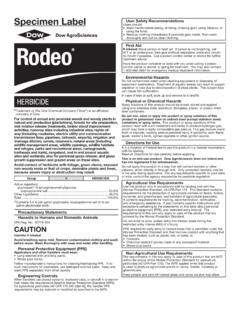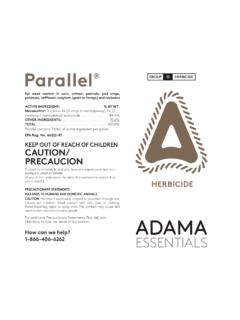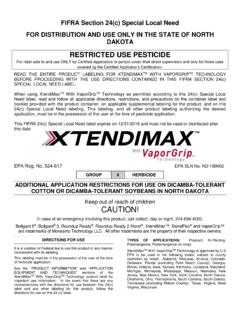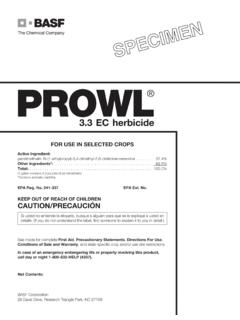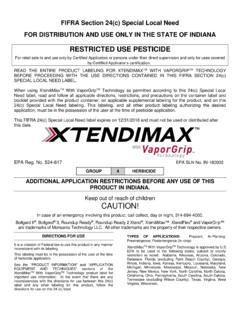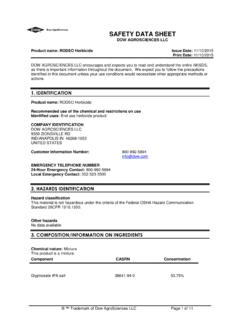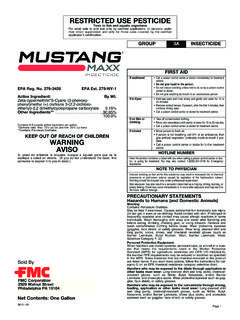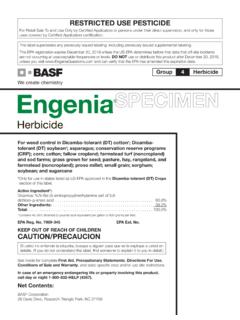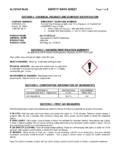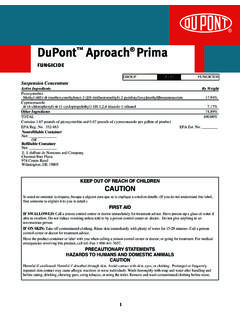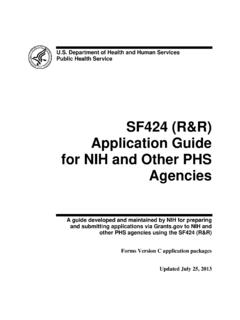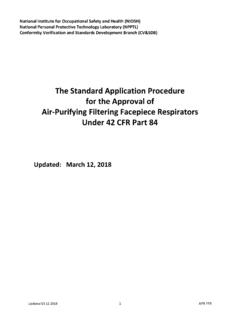Transcription of Supplemental Label - CDMS
1 Group 27 Herbicide Supplemental Label For postemergence control of broadleaf and grass weeds in select turfgrass species on golf courses, sod farms, and residential turfgrass This Supplemental Label expires January 15, 2020, and must not be used or distributed after this date. Active Ingredient: topramezone: [3-(4,5-dihydro-isoxazolyl)-2-methyl-4-( methylsulfonyl). phenyl](5-hydroxy-1-methyl-1H-pyrazol-4- yl)methanone .. Other Ingredients: .. Total: .. 1 gallon contains lbs of topramezone free acid. EPA Reg. No. 7969-327. Directions For Use Product Information It is a violation of federal law to use this product in a Pylex may be applied as a postemergence broadcast manner inconsistent with its labeling. or spot spray to residential and nonresidential turfgrass The Supplemental labeling and the entire including: Pylex herbicide container Label , EPA Reg.
2 No. Airports 7969-327, must be in possession of the user at the Athletic fields time of application. Cemeteries Read the Label affixed to the container for Pylex Golf courses before applying. Grounds or lawns around residential and commercial Use of Pylex according to this labeling is subject to establishments the use precautions and limitations imposed by the Houses of worship Label affixed to the container for Pylex. Military and other institutions Single/Multifamily dwellings Parks Picnic grounds Roadsides Schools Sod farms BASF Corporation 26 Davis Drive, Research Triangle Park, NC 27709. Pylex herbicide is a broad-spectrum systemic postemergence herbicide for control or suppression of broadleaf and grass weeds in select turfgrass species: Bentgrass, creeping*.
3 Bermudagrass**. Bluegrass, Kentucky Centipedegrass Fescue, fine Fescue, tall Paspalum, seashore**. Ryegrass, perennial * Creeping bentgrass is marginally tolerant to Pylex at a rate of fl oz/A. Test on a small area before large-scale use. ** Bermudagrass and seashore paspalum are marginally tolerant and some turf injury can be expected. See Special Weed Control section. Table 1. Postemergence Weed Control* in Turfgrass Weed Species Application Rate Additive Rate Annual Grass Weeds Controlled1. Barnyardgrass to ** fl ozs/A COC or MSO. Crabgrass, large4 or to 1% volume/volume (v/v). Crabgrass, smooth4 to fl oz/1000 sq ft (2 to 4 qts/100 gallons of spray). Crabgrass, southern**,4 ( to mL). Cupgrass, woolly**. Foxtail, giant Foxtail, green Foxtail, yellow**.
4 Goosegrass Johnsongrass, seedling**. Millet, wild proso**. Panicum, fall**. Paspalum, slender Shattercane**. Signalgrass, broadleaf**. Stiltgrass, Japanese**. Velvetgrass, common Windmillgrass Perennial Grass Weeds Controlled/Suppressed Bermudagrass, common2,4 3 applications at to fl ozs/A COC or MSO. Dallisgrass**,4 or to 1% v/v Nimblewill** to fl oz/1000 sq ft (2 to 4 qts/100 gallons of spray). Zoysiagrass4 ( to mL). applied on a 3 to 4 week spray interval Initiate first application mid-to-late summer or approximately 9 weeks to 12 weeks before fall reseeding period for cool-season grasses. Reseeding will aid in the percent conversion of ground cover back to the desired cool-season grass species. (continued). 2. Table 1. Postemergence Weed Control* in Turfgrass (continued).
5 Weed Species Application Rate Additive Rate Broadleaf Weeds Controlled3. Amaranth, Palmer** to ** fl ozs/A COC or MSO. Amaranth, Powell** or to 1% v/v Burcucumber** to fl oz/1000 sq ft (2 to 4 qts/100 gallons of spray). Carpetweed** ( to mL). Chickweed, common**. Clover, large hop**. Clover, white Cocklebur, common**. Dandelion, common**. Galinsoga, hairy**. Ground ivy**. Horseweed (Marestail)**. Jimsonweed**. Kochia**. Lambsquarters, common Mallow, common**. Mallow, Venice**. Morningglory spp.**. Mustard spp.**. Nightshade, black**. Nightshade, Eastern black**. Nightshade, hairy**. Oxalis (Yellow wood sorrel)**. Pigweed, prostrate**. Pigweed, redroot Pigweed, smooth**. Pigweed, tumble**. Prickly lettuce**. Ragweed, common**. Ragweed, giant**. Shepherd's-purse**.
6 Sida, prickly**. Smartweed, ladysthumb**. Smartweed, Pennsylvania**. Speedwell (Veronica spp.)**. Sunflower, wild (common)**. Thistle, Canada**. Thistle, Russian**. Velvetleaf Waterhemp**. * Under certain conditions, a single application of Pylex herbicide may not provide complete control. A sequential application of an additional to fl ozs/A of Pylex 2 to 3 weeks after initial treatment may be necessary. ** Use rate may be increased up to fl ozs/A ( fl oz/1000 sq ft) in Kentucky bluegrass only. ** Not for use in California 1. To improve control of annual grass weeds, make applications before the fourth tiller growth stage. Use the fl oz/A rate for annual grass weeds up to the second tiller growth stage. For annual grass weeds in the 2 to 4 tiller stage, apply fl ozs/A.
7 2. Control of these species requires a tank mix with triclopyr ester at 32 fl ozs/A (1 lb ae/A). 3. To improve control of broadleaf weeds, make applications at early growth stages. To increase broadleaf weed species control spectrum, a tank mix with 2,4-D; triclopyr; or other broadleaf herbicide may be used. 4. See Special Weed Control section 3. Special Weed Control Control of goosegrass in Bermudagrass and seashore paspalum: Apply a single application of Pylex herbicide at fl oz/A to fl oz/A with MSO to actively growing goosegrass. Bleaching/. discoloration can be expected to the desired turfgrass for 2 to 4 weeks. Apply as a spot spray or area spray to goosegrass infested areas at any growth stage. Large broadcast sprays may be objectionable due to significant bleaching for a prolonged period of time.
8 A. sequential application in Bermudagrass and seashore paspalum may result in significant turfgrass damage. Selective control of Bermudagrass in cool-season turfgrass: Pylex can be used in combination with triclopyr ester (1 lb ai/A) to improve Bermudagrass control over Pylex applied alone. Make three applications of Pylex at fl ozs/A with MSO and triclopyr at three week intervals or make two applications of Pylex at fl ozs/A with MSO and triclopyr followed three weeks later by Pylex at 1 fl oz/A. with MSO and triclopyr. Begin applications in late summer when Bermudagrass is approximately 9 to 12 weeks from first killing frost. DO NOT apply more than 4 fl ozs Pylex per acre per year. Delay seeding of desirable turfgrass species for 3 weeks after last application.
9 The combination outlined above may require multiple years of applications to completely control Bermudagrass in cool-season turfgrass. Non-selective control of Bermudagrass: Pylex can be used in combination with glyphosate to improve Bermudagrass control over glyphosate applied alone. Apply Pylex at 2 fl ozs/A with MSO in a tank mix with glyphosate (use labeled rate for Bermudagrass) to control Bermudagrass. If necessary, a second application may be made to control remaining Bermudagrass. DO NOT apply more than 4 fl ozs Pylex per acre per year. Seeding of cool-season species (fescues, ryegrass, Kentucky bluegrass) can be performed immediately after application. Delay seeding bentgrass for 2 weeks. Warm season species (Bermudagrass and seashore paspalum) can be seeded, sprigged or sodded two weeks after application.
10 Control of zoysiagrass: Make three applications of Pylex in late summer on a three week interval, prior to the onset of zoysiagrass dormancy. Improved and more consistent control of crabgrass: Apply Pylex at fl oz/A tank mixed with 32 fl ozs/A of Drive XLR8. A sequential application may be required. Improved dallisgrass control: Add 32 fl ozs/A of triclopyr ester and make two applications three weeks apart. 4. Conditions of Sale and Warranty The Directions For Use of this product reflect the opinion of experts based on field use and tests. The directions are believed to be reliable and must be followed carefully. However, it is impossible to eliminate all risks inherently associated with the use of this product. Plant injury, ineffectiveness or other unintended consequences may result because of such factors as weather conditions, presence of other materials, or use of the product in a manner inconsistent with its labeling, all of which are beyond the control of BASF CORPORATION ( BASF ) or the Seller.
